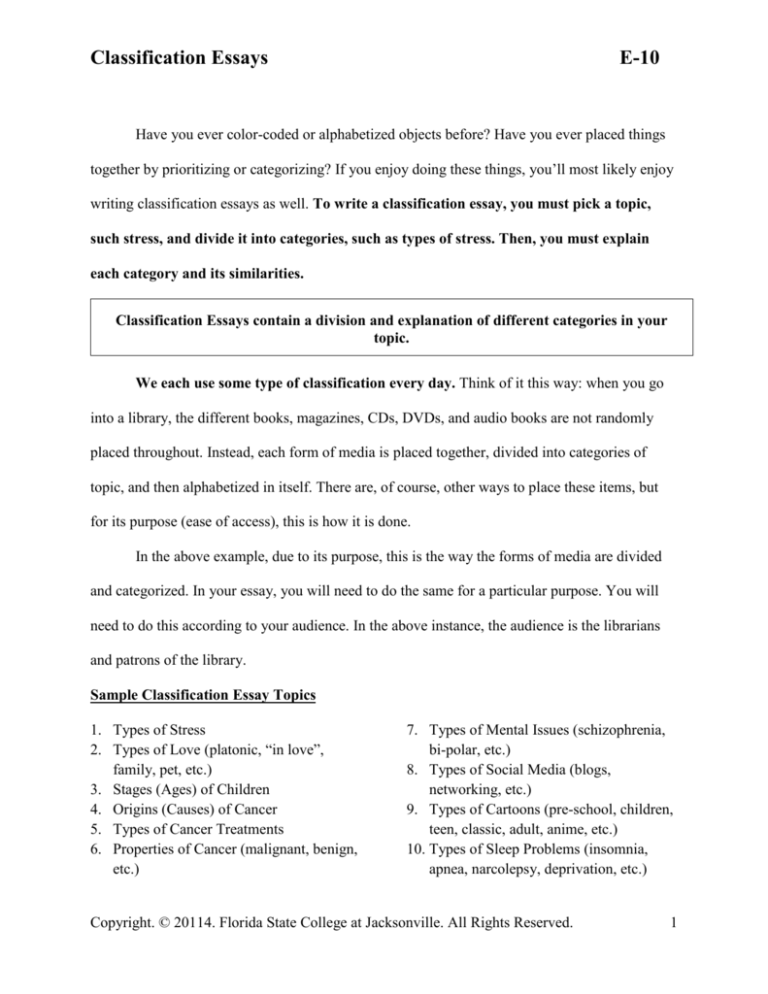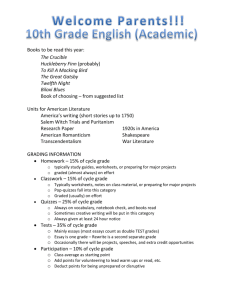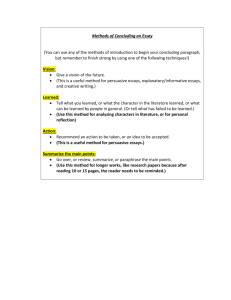
Classification Essays
E-10
Have you ever color-coded or alphabetized objects before? Have you ever placed things
together by prioritizing or categorizing? If you enjoy doing these things, you’ll most likely enjoy
writing classification essays as well. To write a classification essay, you must pick a topic,
such stress, and divide it into categories, such as types of stress. Then, you must explain
each category and its similarities.
Classification Essays contain a division and explanation of different categories in your
topic.
We each use some type of classification every day. Think of it this way: when you go
into a library, the different books, magazines, CDs, DVDs, and audio books are not randomly
placed throughout. Instead, each form of media is placed together, divided into categories of
topic, and then alphabetized in itself. There are, of course, other ways to place these items, but
for its purpose (ease of access), this is how it is done.
In the above example, due to its purpose, this is the way the forms of media are divided
and categorized. In your essay, you will need to do the same for a particular purpose. You will
need to do this according to your audience. In the above instance, the audience is the librarians
and patrons of the library.
Sample Classification Essay Topics
1. Types of Stress
2. Types of Love (platonic, “in love”,
family, pet, etc.)
3. Stages (Ages) of Children
4. Origins (Causes) of Cancer
5. Types of Cancer Treatments
6. Properties of Cancer (malignant, benign,
etc.)
7. Types of Mental Issues (schizophrenia,
bi-polar, etc.)
8. Types of Social Media (blogs,
networking, etc.)
9. Types of Cartoons (pre-school, children,
teen, classic, adult, anime, etc.)
10. Types of Sleep Problems (insomnia,
apnea, narcolepsy, deprivation, etc.)
Copyright. © 20114. Florida State College at Jacksonville. All Rights Reserved.
1
Classification Essays
E-10
Classification Outline/Graphic Organizer
Type, Group, Class,
or Category 1:
Type, Group, Class,
or Category 2:
Topic:
Type, Group, Class,
or Category 3:
Type, Group, Class,
or Category 4:
Copyright. © 20114. Florida State College at Jacksonville. All Rights Reserved.
2
Classification Essays
E-10
Example Classification Outline
Type, Group, Class,
or Category 1:
Type, Group, Class,
or Category 2:
Physical Issues
Gender
Topic:
Stress
Mental Issues
Age
Type, Group, Class, or
Category 3:
Type, Group, Class,
or Category 4:
Copyright. © 20114. Florida State College at Jacksonville. All Rights Reserved.
3
Classification Essays
E-10
Be as specific or general as you like. Outlines are used to remove any unnecessary
information, gain a focus, and remove Writer’s Block. If you want to write out more
information, details can be written below each section of your topic.
Example Classification Essay
Affecting Various Demographics:
Dynamics of Stress
Stress is something everyone hears about on a daily basis in today’s American society.
Who does stress affect, though? What does stress do? When and where does stress occur? Stress
can be a fickle subject as it varies from person to person. Stress affects everyone, taking short
and long-term effect, but it is according to one’s age and gender as well as mental and physical
heath how stress affects a particular individual.
In psychology, stress is defined as “The pattern of specific and nonspecific responses an
organism makes to stimulus events that disturb its equilibrium and tax or exceed its ability to
cope” (American Psychological Association, 2012). So, is stress the difficulties a middle-aged
woman is having in her marriage, though? What about the man who just graduated from college,
tied up in debt? Is stress the answer to what is happening to the baby squirming around because
of a high-pitched noise? Yes, all of these people are being inflicted with stress. No one is free
from stress; it affects everyone today. Stress affects people differently, according to gender, age,
and such because of the values and actions that people uphold as important. Even though it is
evident that stress affects people differently, how is this so?
Short-term/Traumatic Stress
Short-term stress refers generally to a one-time incident of stress. Sometimes stress can
be referred to as trauma; this is where people are under an immense amount of stress in a short
amount of time. (Garner, A., et al, 2012).
Copyright. © 20114. Florida State College at Jacksonville. All Rights Reserved.
4
Classification Essays
E-10
Positive vs. Negative Stress. Generally speaking, there are two types of stress: negative
and positive stress. People are somewhat aware of what negative stress is, like stress leading to
depression, etc. What is positive stress though? Positive stress is the occasional occurrences of
stress where someone learns something valuable or has a positive outcome. For instance,
sometimes the stress from competing in sports, getting good grades, and peer-pressure can be
examples of constructive outcomes. This type of stress is also generally short-term (Updegraff,
J., et al, 2000).
Age Distinctions. Younger people are prone to stress that lasts for smaller periods of
time. Those of infancy and childhood, which is from birth to about twelve years of age (“preteen” years), are more inclined to traumatic stressors. Examples of such would be child abuse,
loss of a parent (permanently or temporarily), bullying, and any type of accident causing injury,
etc. All of these situations are causal for short-term stress as each individual incident can be
considered as such.
Children are stressed by all kinds of things. A short-termed stress that affects this group
immensely is noise. Loud sounds or noises create abrupt and short pangs of stress. Whenever one
hears a loud noise they are startled and bothered by this noise. Prolonged loud noises can cause
hearing problems later in life if not immediately introduced. Too much noise around an infant
can overload their sensory capacity and cause them to fall asleep (Franklin Institute Online,
2004).
Teenage years are well-known for being difficult; stress is a large factor in this. Besides
the stress of the latest acne break-out, adolescents endure stress through competitions,
relationships, assessments, and peer pressures. These stressors are all considered to be shorttermed, as each instance is independent from others, as well as the fact that each occurrence is
separate. An excess amount of hormones is largely in part for stress during teenage years
(WebMD, 2012).
Although the 20’s and 30’s have always been considered the prime of one’s life, many
young people are now finding that they suffer from stress, specifically short-term. It is evident
Copyright. © 20114. Florida State College at Jacksonville. All Rights Reserved.
5
Classification Essays
E-10
that many younger adults are feeling trapped by the many choices they have as options, as well
as the time in which they have to derive their decision; they have just become “all growed-up”.
They also undergo stress in the form of fears of marriage, jobs/schooling, death, aging, debt, as
well as feelings of shame, boredom, frustration, nostalgia, and uselessness.
A new term has been devised to describe this phenomenon– “Quarter-Life-Crisis”. This
adversity shows the discontent that many people now feel because they want instant gratification,
which isn’t possible in all of life’s situations. However, those that are better educated, are more
likely to experience stress (theguardian, 2011).
Long-term Stress
Long-term stress is extremely different from short-term; it is a strain on someone that
recurs over time. Generally, long-term stress takes a larger toll on persons being stressed, but one
can adapt if stress occurs overtime. However, that doesn’t necessarily mean the adaption they
make is a positive one. Also, long-term stress can be the same event of short-term stress repeated
multiple times. For instance, if someone is constantly bullied each day they go to school or work,
then this constant stressor becomes long-term (Garner, A., et al, 2012).
Infancy. Births to Five-years-olds are the crucial years in anyone’s life; it is almost like
the foundation for the rest of one’s life. During these years one learns to move, walk, talk, eat,
etc. Stress during this period in life can cause a myriad of problems that produce a daisy chain of
other associated problems later in life. It may also prevent a child from reaching important
milestones in one’s life. For example, a child, about three-years-old, is abused by one of their
parents. This happens continuously until the child is about five, when the child is separated from
the parent. When the child grows older, they refuse to adhere to any authority figures of the same
age as the abusive parent. The child also cannot agree with any peers of the same gender of the
parent. Eventually, the child develops a social disorder from becoming a pariah. This developed
disorder may cause the child to drop out of high school and become incapable of keeping a
steady job (Better Brains for Babies, 2012).
Copyright. © 20114. Florida State College at Jacksonville. All Rights Reserved.
6
Classification Essays
E-10
Prepubescent. A large source of stress for children in the U.S. today is the divorce or
separation of one’s parents. People may think that divorce only affects the separatists, but it more
drastically seems to affect the children. These children sometimes feel that the reason their
parents are separating is strictly because of them; the children are too naïve to realize the actual
reasons behind the divorce. Stress during this time can be more permanent than the stress of
adulthood due to the fact that the brains of children are still developing (Middlebrooks, et al,
2008).
Adolescence. Everyone who has been through it remembers it- being a teenager. One’s
hormones increase as their body begins to grow and develop. These somewhat sudden changes
create stress, physically as well as mentally. This development occurs into the early 20’s, when
one becomes an adult. Still there are other things that stress these cranky teenagers. In the
teenage years, there is a more evident divide between male and female reactions to stress, such as
lacks of sleep, pressure of testing/grades, peer pressure, as well the pressure of growing up.
However, for teenage girls, they have the pressure of the process of their growth in the
development of their menstruation cycles. Female teenagers focus on making others outcasts.
Such an instance would be when a girl is labeled “too friendly” with her male companions. Male
teenagers are pressured into “brotherly” affirmations, where things must be done to be accepted.
For instance, trying this-or-that illegal substance or pressuring a girl into sex (Nature Reviews,
2012).
Adulthood. They say men are from Mars and women are from Venus. Is this also the case
when pertaining to stress? How can men and women differ in their overall reactions with stress
and its management? Although men and women can be stressed by the same things, it is
recognizable that there are significant differences between men and women in the duration of
their stress(es) as well as the level of their stress(es).
According to the Journal of Abnormal Psychology, aggressions resulting from stress give
different reactions within men and women. An example of such is a study, which used the
stressor of an air horn to then measure the intensity of shocks or the startle reflex between men
Copyright. © 20114. Florida State College at Jacksonville. All Rights Reserved.
7
Classification Essays
E-10
and women. The responses between the participants were measured on how the stressor affected
them and what their reactions were (2011). This study has shown that men and women react with
stress and did not differ in their reaction with the startle reflex. On the other hand, men and
women did differ in their responses to aggression.
Men, when under high stress, show patterns of increased aggression, more so than male
participants under less stress. In contrast, women, when under so much stress, tend to act with
less aggression, even while compared to female participants with less stress levels. The study
shows that both men and women are affected similarly by stress when under pressure but their
reactions are different in that men act more aggressively. Studies have shown that 28% of
women vs. 20% of men are more likely to report a great deal of stress (American Psychological
Association, 2012).
Despite the consequences of stress and its sources, including the signs and symptoms of
physical and emotional stress, men and women are different in managing their stress. However,
most of them choose activities like reading, listening to music, and watching television, which
are sedentary activities, to manage their stress instead of exercising and seeking professional
mental health counselors (American Psychological Association, 2012).
Middle-Adulthood. The Mid-life crisis is a well-known occurrence among men. They
become middle-aged, facing their mortality. However, women go through this same process as
men do, though it is not as evident. Women become more creative, perhaps go back to school
after the nest has emptied. Men buy and spend all of their time playing with their new
convertible sports cars, etc. This in itself shows how men and women react differently to stress
(Team Technology, 2012).
Senior-Adulthood. What do old people have to worry about? Seniors must make sure all
of their assets are accounted for. In today’s society, however, seniors must worry about
retirement and funding for such. Even if they can no longer work, seniors must have the
necessary funding to live from day-to-day. Social Security checks and retirement funds are no
longer enough. Besides money issues, stress for seniors is caused by frustration from lack of
Copyright. © 20114. Florida State College at Jacksonville. All Rights Reserved.
8
Classification Essays
E-10
independence. As one grows older, they progressively lose their capability of independence.
Women suffer more from this stressor as they live longer than their partners and then must be
bustled into retirement homes, family homes, etc. (Nature Reviews, 2012).
Mental Issues
A twig snapping under pressure is almost an exact example of one under stress.
Sometimes, they snap without the proper care. This doesn’t mean issues are permanent, but
rather, it means that it just sometimes happens. All sorts of disorders develop because of stress.
Examples of such are depression, phobias, PTSD, and anxiety disorders.
Depression. Depression is a very obvious and serious issue developed from stress. People
with depression begin to lose interest in their day-to-day activities. They also become sad and
feel useless as well as develop thoughts of suicide. An example of such is when one works as a
teacher. This teacher constantly tries new ways to get through to their students while trying to
prepare them for standardized tests. The students still do poorly on these assessments. The
teacher eventually loses their job for seemingly being incompetent. Now, feeling useless, this
former teacher grows into depression (National Cancer Institute, 2012).
Phobias. There are several ways in which phobias are developed. However, phobias
developed due to stress are generally the result of a traumatic event (AnxietyBC, 2011). A child
developing a phobia of dogs after being bitten and rushed to the hospital could be an example of
such.
Post-Traumatic Stress Disorder (PTSD). PTSD is “An anxiety disorder characterized by
the persistent re-experience of traumatic events through distressing recollections, dreams,
hallucinations, or dissociative flashbacks; develops in response to rapes, life-threatening events,
severe injuries, and natural disasters” (ConqueringAnxietyandDepression.com, 2012).
This type of disorder is more permanent than other disorders. Anytime PTSD is formed, it is
caused from stress. The most common trauma, but not known as such, that results in PTSD, is
that of rape (ConqueringAnxietyandDepression.com, 2012).
Copyright. © 20114. Florida State College at Jacksonville. All Rights Reserved.
9
Classification Essays
E-10
Anxiety Disorders. Anxiety disorders raise the blood pressure and can cause serious
permanent damage. Sometimes, these disorders can lead to heart attacks, etc. These disorders are
not always permanent, and there are ways to prevent such. Still, these cases are not generally
properly handled. This could be due to individuals altogether not wanting to face particular
issues regarding the situations of anxiety (ConqueringAnxietyandDepression.com, 2012).
Physical Issues
Pertaining to stress, physical issues include the way one responds to such. However,
physical issues also include exhaustion as well as an improper balance of weight. Although not
as harmful as mental issues, physical issues can lead to long-lasting effects.
Stress Responses. Research has shown that when it comes to stress response, men react
with what UCLA researchers call “flight-or-flight” responses, while women manage their stress
with a “tend-and-befriend” response. Males who respond to stress with the “flight-or-flight”
response tend to react with aggressive behavior. They may talk harshly with their family or
remove themselves from situation, find a peaceful place, or may want to be alone (Franklin
Institute Online, 2004). This is why men tend to be more at risk in developing adverse reactions
from stress. They are more likely to have stress-related issues like hypertension, overeating,
aggressive behavior, alcohol abuse, or hard drugs.
Shelley E. Taylor, a Psychology Professor and lead researcher of the study states that
when a woman is stressed out from work, the general response is to protect and nurture her
young (the “tend” response). For example, when a woman comes home from a bad workday, the
tendency is to shift the focus and attention to the care of her children at home. Although a
woman may have feelings of stress, she still reaches out to others who may need help. In
addition, a woman seeks social contact from usually another woman for support (the “befriend”
response). Some of the ways a woman expresses the “befriend” response is by being overly
friendly to anyone and everyone. By this natural reaction, women who have social friends that
they can connect with, is more capable of giving much better care for their children. On the
Copyright. © 20114. Florida State College at Jacksonville. All Rights Reserved.
10
Classification Essays
E-10
other hand, Professor Taylor added, that this partly explains why women live an average of
seven and a half years longer than men. (American Psychological Association, 2012)
Hormones. Hormones are one of the reasons why men and women react differently to
stress. Oxytocin, epinephrine, and cortisol are the hormones that play crucial roles. When stress
is introduced, the cortisol and epinephrine raises blood pressure as well as the blood sugar level.
Cortisol weakens the immune system function. Robert Sapolsky, PhD and professor of
neurobiology at Stanford University, believes that there are no correlations between what causes
increased levels of cortisol in men and women. There are some who think that the differences in
the released level of cortisol during stressful times between men and women affect the
differences of their response to stress as well. According to Sapolsky, women release more
cortisol when in stress, which leads to an emotional reaction. Sapolsky added that the hormone
oxytocin is what causes the difference in men and women when regarding to stress responses.
His theory is, when women are under stress, cortisol and epinephrine rush through the
bloodstream. Oxytocin is then released from the brain countering the epinephrine and cortisol
production, promoting nurturing and relaxing emotions. Men, in contrast, secrete smaller
amounts of oxytocin when under stress, which leaves them shorthanded when it comes to
hormones (WebMD, 2012).
Conclusions
At times stress can be a positive experience. However, more often than not, stress is
negative. Over time stress develops from short-term stress into long-term, changing the effects
and who it is being affected. Be that as it may, stress can affect anyone and does affect everyone.
There are still ways to prevent and relieve stress and related issues. All that is really necessary,
however, is the knowledge of stress and its effects.
Copyright. © 20114. Florida State College at Jacksonville. All Rights Reserved.
11
Classification Essays
E-10
References
American Psychological Association (2012). Gender and Stress. Retrieved from
http://www.apa.org/news/press/releases/stress/gender-stress.aspx
AnxietyBC (2011). How does a phobia develop? Where do phobias come from? Retrieved from
http://www.anxietybc.com/resources/specific.php
Better Brains for Babies (2012). Better Brain for Babies. Retrieved from
http://www.fcs.uga.edu/ext/bbb/stressEffects.php
ConqueringAnxietyandDepression.com (2012). How is Stress Related to Mental Illness?
Retrieved from http://www.conqueranxietyanddepression.com/AnxietyStress/How_Is_Stress_Related_To_Mental_Illness.html
Franklin Institute Online (2004). The Human Brain. Retrieved from
http://www.fi.edu/learn/brain/stress.html
Garner, A., Shonkoff, J., Siegel, V., Dobbins, M., Earls, M., Garner, A., McGuinn, L., Pascoe, J.,
Wood, D. (January 1, 2012). Pediatrics. Received from
http://aappolicy.aapublications.org/cgi/content/abstract/pediatrics;129/1/e224
Journal of Abnormal Psychology (2011). Gender Differences in Combat-Related Stressors and
Their Association with Post-deployment Mental Health in a Nationally Representative
Sample of U.S. OEF/OIF Veterans. Retrieved from
http://www.apa.org/pubs/journals/releases/abn-120-4-797.pdf
Middlebrooks, J., Audage, N. (2008). The Effects of Childhood Stress on Health Across the
Lifespan. Received from http://www.cdc.gov/ncipc/pub-res/pdf/childhood_stress.pdf
National Cancer Institute (2012).
Psychological Stress and Cancer: Questions and Answers. Retrieved from
http://www.cancer.gov/cancertopics/factsheet/Risk/stress
Nature Reviews (2012). Effects of Stress throughout the Lifespan on the Brain, Behavior, and
Cognition. Received from http://www.nature.com/nrn/journal/v10/n6/full/nrn2639.html
theguardian (2011). The Quarterlife Crisis: Young, Insecure and Depressed. Retrieved from
http://www.guardian.co.uk/society/2011/may/05/quarterlife-crisis-young-insecuredepressed
University of Maryland Medical Center (2011). Biofeedback. Retrieved from
http://www.umm.edu/altmed/articles/biofeedback-000349.htm
Updegraff, J.A., & Taylor, S.E. (2000). From vulnerability to growth: Positive and negative
effects of stressful life events. In J. Harvey & E. Miller (Eds.) Loss and Trauma: General
and Close Relationship Perspectives (pp. 3-28). Philadelphia, PA: Brunner-Routledge.
WebMD (2012). Why Men and Women Handle Stress Differently. Retrieved from
http://women.webmd.com/features/stress-women-men-cope
Team Technology (2012). Mid-Life Crisis, Stress, and Depression. Retrieved from
http://www.teamtechnology.co.uk/tt/t-articl/midlife.htm
[Generally, APA Reference pages are double spaced.]
Copyright. © 20114. Florida State College at Jacksonville. All Rights Reserved.
12





